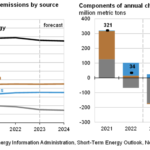Energy News Beat
Key Takeaways
Carbon Dioxide emissions are estimated to drop 3 percent this year as coal plants are idled and retired and natural gas mostly picks up the slack.
Carbon dioxide emissions increased in 2021 and 2022 as the impact of forced COVID closures that hammered energy consumption and economic growth faded.
Global carbon dioxide emissions are going in the opposite direction, with a predicted 1 percent increase in emissions led by China, the world’s largest emitter by far.
U.S. coal consumption will reach its lowest level since 1973 despite an economy over 3.4 times larger in real terms.
President Biden has promised the United Nations that the United States will reduce carbon dioxide by 50 to 52 percent of 2005 levels by the end of 2030, but this year they are expected to be only at a 20 percent reduction from 2005 levels.
Biden plans on spending hundreds of billions of taxpayer dollars subsidizing renewable energy and other “green technologies” to produce almost 150 percent of the reductions in the last 18 years over the next 7 years.
China is benefiting from Biden’s plan, as it allows them to burn over half the world’s coal to make products Biden is demanding Americans buy.
After increasing for two years in a row, U.S. carbon dioxide emissions are expected to drop by 3 percent this year and then another 0.7 percent next year, according to the Energy Information Administration (EIA) in its most recent Short-Term Energy Outlook. The 0.7 percent drop in 2024 is the expected annual drop in carbon dioxide emissions by 2050, resulting in a 19 percent drop in emissions from 2022 levels projected by EIA’s Annual Energy Outlook. By 2030, EIA expects a 17 percent drop in CO2 emissions, despite the Biden goal of at least a 50 percent drop. EIA’s forecast shows that most of the gain in emissions reduction is by 2030 as reductions in carbon dioxide emissions slow dramatically thereafter.
The 3 percent drop in carbon dioxide emissions this year is mainly due to lower coal consumption, down 18 percent from 2022. Emissions from petroleum are unchanged as falling gasoline consumption is offset by rising consumption of jet fuel and diesel, and emissions from natural gas increase slightly. The decrease in emissions represents a resumption of the fairly steady emission declines the United States recorded over the 15 years leading up to the Covid-19 pandemic. Carbon dioxide emissions plunged during the lockdowns of 2020, as people stayed home, and rebounded partially in 2021 and slightly more in 2022.
Source: EIA
Generation Sector Accounts for Most of the Declines
EIA expects power plants, which account for 90 percent of coal consumption, to consume 384 million tons this year, the lowest level since 1973 despite the GDP of the United States now being over 3.4 times as large as it was then, adjusting for inflation. Coal generated 376 billion kilowatt hours of electricity through the end of July, down 24 percent compared with the same period in 2022. Coal is expected to fall to 16 percent of electricity production this year from 20 percent last year. The loss in coal generation is being filled primarily by natural gas, which is up 8 percent over 2022 levels and is on track to account for 42 percent of power generation. Natural gas has been attractive because of its abundance and resulting low price. Wind and solar generation are essentially flat with combined output of 353 billion kilowatt hours through July. EIA expects renewable generation, including hydro, to account for around 22 percent of power generation in 2023.
Steady declines in coal use have powered American carbon dioxide emission reductions, which are expected to be down 20 percent from 2005 levels this year and by 33 percent by 2030. Biden’s commitment to the United Nations Paris Agreement, however, calls for cutting emissions 50 to 52 percent of 2005 levels by the end of 2030. To so that he plans on spending hundreds of billions of taxpayer dollars subsidizing renewable energy and other “green technologies” to produce almost 150 percent of the reductions in the last 18 years over the next 7 years.
Despite the steady declines in emissions reductions from the power sector by reducing coal use and EIA’s expectations for further emissions reductions, it is unclear if the United States can accelerate the renewable development needed to get the further emission reductions needed for Biden’s goal from the generation sector. Inflation, higher interest rates and supply chain bottlenecks are making it more expensive to build new renewable projects. Offshore wind is having a very difficult time as several projects have been canceled, despite developers having to pay penalties. Expectations are now for 16 gigawatts of offshore wind by 2030, down almost half from Biden’s goal of 30 gigawatts.
Wind and solar projects are having to wait to be connected to the power grid as grid operators are trying to ensure reliability of the system before connecting them, which is complicated by the weather-driven intermittency of those sources of energy. Transmission constraints and lengthy permitting timelines have delayed new projects from coming online. Wind development in particular has stalled, hampered by lengthy permitting timelines and transmission constraints. New onshore installations are expected to hit 8.3 gigawatts this year, down from more than 14.2 gigawatts in 2020, at the height of COVID. EIA expects new wind installations to fall to 6.4 gigawatts in 2024 and 5.6 gigawatts in 2025.
World Carbon Dioxide Emissions Expectations
Global carbon dioxide emissions are expected to increase to an all-time high this year, up around 1 percent from 2022, despite the U.S.’s reductions. The main sources for emissions are energy consumption (electricity and heating), transport (cars, planes), manufacturing, construction and food production. Global emissions from the oil sector are expected to increase by 2.2 percent, followed by the cement and coal industry, while those from natural gas are expected to be stable.
Conclusion
The United States has a way to go to meet Biden’s goal for carbon dioxide reductions, despite making headway in reducing emissions in the power sector this year by reducing coal consumption even more. However, U.S. emissions reduction of 3 percent is in the right direction compared to world carbon dioxide emissions that are expected to grow by about one percent this year to an all-time high. Carbon dioxide emissions growth is led by China, who uses more than half of the world’s coal consumption to manufacture “green energy” products for wealthy countries to use to reduce their carbon dioxide emissions. It uses coal because it is cheap and reliable, unlike intermittent and weather-driven wind and solar energy. The situation is clearly ironic.
The post U.S. Carbon Dioxide Emissions Expected to Decline by 3 Percent This Year appeared first on Energy News Beat.








